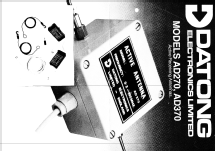SDRplay RSPduo
Since June 2018 a special SDR is available. The SDRplay RSPduo. This small black box receiver contains two identical receivers equipped with the Mirics MSi2500 tuner module, which offers continuous reception from 1KHz - 2000MHz. The two receivers in the RSPduo are exactly the same as in the predecessor RSP2pro. Only, they are duplicated. This concept opens up new possibilities in signal monitoring and processing. Jon Hudson from SDRplay, provided me the RSPduo for tests and comparisons.
The most important key data of the RSPduo |
Below: SDRuno in dual mode. Both tuners are active and can receive independently on different frequencies. Very interesting for comparisons. Upper receiver on shortwave 6155KHz, lower receiver on FM 102.5MHz in stereo and with RDS output.
SDR Console V3.03
The RSPduo can also be controlled with the well-known SDR console V3. The V3.03 version shown here only supports one tuner. But the full RSPduo support will coming soon.
Working with the RSPduo
The RSPduo is a true broadband receiver that receives up to 2GHz. Since I am mainly concerned with the long, medium and shortwave, I have tested only these frequency ranges in detail. As a comparison device, I primarily used the Winradio G33DDC Excalibur Pro. This is in my opinion the best SDR in the affordable range and is for me the reference receiver. Hobby-usual active antennas were used. The NTi ML200 Loop with 1m diameter, the crossloop also with 2x 1m diameter, the active dipole Datong AD370 and the Stampfl HB9KOC active dipole with a dipol length of 1m.
The RSPduo receives at the lowest frequencies with the same sensitivity as the G33DDC !. Both devices brought almost the same level. The lowest frequency a station could hear was at 16.4KHz. Send here
Picture below: Reception comparison on submarine frequencies! At 16.4KHz, JXN is available from Norway. Antenna: Datong AD370.
| . |
On all other frequencies hardly any differences to the G33DDC are noticeable. Only the playback characteristics of the audio can sometimes hear differences. Sometimes one, sometimes the other is better. How does the RSPduo sound in comparison to my reference device, the G33DDC? Audio comparisons say more than words! For the comparison I made audio recordings of the two receivers. The best way to convince yourself, listening to the recordings. When selecting the stations, I have put emphasis on mostly bad receivable stations. Therefore, I recommend to use a headphone while listening to the comparisons.

